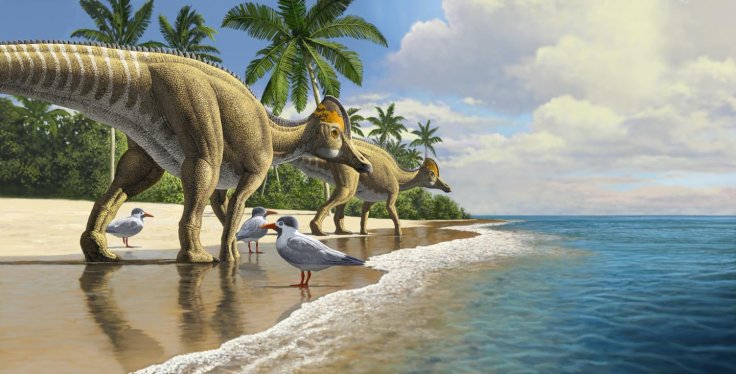Of all the prehistoric creatures that went extinct, dinosaurs are perhaps the most fascinating. Every fossilized remain is a time capsule waiting to be unlocked, and its ancient secret waiting to be learnt. Uncovering one such mystery, scientists have discovered the very first fossils of a duckbilled dinosaur in Africa, which suggests that the creature traversed across hundreds of kilometers of open ocean to arrive on the continent.
The fossil of the newly identified pony-sized dinosaur, Ajnabia odysseus, was found in modern-day Morocco, at a mine near the famed city of Casablanca. Ajnabia's reliquiae unearthed amongst rocks dating back to the end of the Cretaceous period 66 million years ago. According to the international team of paleontologists, finding the remains of the duckbilled dinosaur in Africa was astonishing.
"It was completely out of place, like finding a kangaroo in Scotland. Africa was completely isolated by water - so how did they get there?" expressed Dr. Nicholas Longrich, lead author of the study, in a statement.
Making An Impossible Journey

Duck-billed dinosaurs were a heterogeneous group of herbivores who reached lengths of up to 15 meters. However, in comparison to all the other larger members of the family, Ajnabia stands dwarfed at only 3 meters in length. Analysis of its jawbones and teeth revealed that the dinosaur belonged to a subfamily of duckbills known as Lambeosaurinae. These dinosaurs had intricate elaborate bony head crests.
Lambeosaurinae had the same evolutionary trajectory as all the other duckbills (i.e) they evolved in North America, and gradually spread to Asia, Europe, and to South America. Therefore, find the relatively puny dinosaur in Africa left the scientists amazed. Through the reconstruction of duckbill evolution, the authors concluded that after revolving in North America, they reached Asia through a land bridge at the time.
Next, they headed to Europe, and eventually Africa. Keeping in mind this exceptional journey that the duckbill undertook, the authors christened it Ajnabia odysseus. Ajnabi is Arabic for "foreigner" while Odysseus is a reference to the legendary Greek explorer.
Finding Their Way to An Isolated Land

So the important question that baffled the researchers was, "How did the Ajnabia make its way to Africa?" Africa was a geographical pariah at the time that was isolated from other continents by deep oceans. For the duckbills to reach such an inaccessible land, they would have had to cross several hundred kilometers of open water. The authors concluded that Ajnabia simply did. Probably swimming, or floating or rafting of debris; they arrived and colonized Africa.
The case for them swimming their way to the continent may be a strong one as duckbills are said to possess the physical requisites of strong swimmers—they had powerful legs and large tails. Also, their remains have been found in marine rocks and river deposits, thereby, suggesting that they just swam to Africa.
"It was impossible to walk to Africa. These dinosaurs evolved long after continental drift split the continents, and we have no evidence of land bridges. The geology tells us Africa was isolated by oceans. If so, the only way to get there is by water," emphasized Longrich.
Drawing A Logical Conclusion

While Ajnabia's feat seems like an impossible one, it is not an undocumented one. Despite being rare, ocean crossings have been observed in the distant past. For example, green iguanas are known to have hopped from one island to another in the Caribbean through debris carried by a hurricane.
"Over millions of years. Once-in-a-century events are likely to happen many times. Ocean crossings are needed to explain how lemurs and hippos got to Madagascar, or how monkeys and rodents crossed from Africa to South America," said Longrich.
Nevertheless, the spread of duckbills and other dinosaurs, in spite of extremely high sea levels, indicates that dinosaurs journeyed through oceans also. "As far as I know, we're the first to suggest ocean crossings for dinosaurs," noted Longrich.
Pointing to the rarity and the importance of the finding, Dr. Nour-Eddine Jalil, co-author of the study, said, "Ajnabia shows us that hadrosaurs have set foot on African land, telling us that ocean barriers are not always an insurmountable obstacle."









